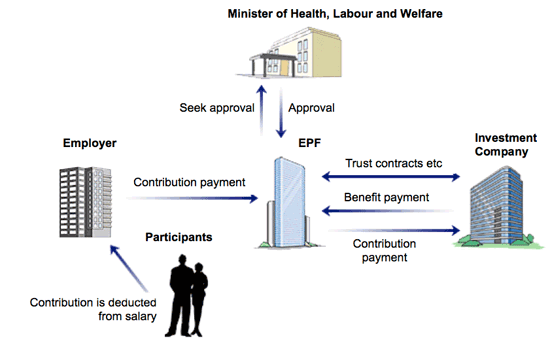
EPF
Employees' Pension Fund (EPF) is a type of DB plan contracting out of social welfare pension. The fund provides a part of earnings-related portion of the statutory Employee's Pension on behalf of government and plus "α" portion which is a top-up portion on the basic part of the EPFs.
The types of EPF:
Single employer EPF
-EPF established by a single employer
Affiliated employer EPF
-EPF established by group companies
Multi-employer EPF
-EPF established by several employers in the same sector or same region
The number of EPFs, especially single & allied employer EPFs, has been in steady decline since a decade ago.

Employer contributions are tax deductible and employee contributions are deductible for social insurance premium.
Characteristics

An EPF is a juridical person established pursuant to the Employees' Pension Insurance Act with the approval of the minister of Health, Labour and Welfare.
EPF pays a part of the earnings-related portion of statutory employees' pension on behalf of the government (Daiko-portion), but since the benefit provided by EPF must be greater than the statutory level; therefore it adds a slight top up called "plus alpha portion". Daiko and plus alpha portions are called "basic portion".
Supplemental benefit is paid in addition to Daiko portion. (Supplemental portion)
Participants
Eligibility
1. Participants
All the employees of the EPF participating company who are the insured under the Employees' Pension Insurance become participants of the basic portion. Eligibility for the basic and supplemental portions should ideally be the same from the perspective of equal treatment. But the supplemental portion could accept transfers from other retirement benefit plans such as unfunded retirement allowance plan, and therefore the eligibility for the supplemental portion could be restricted to those eligible for the transferred plan on certain conditions.
a. In principle, all participants must qualify for the supplemental portion
b. However, employers may exclude certain group of employees from participation eligibility when qualifying all participants is difficult due to differences in working conditions such as mandatory retirement age, salary, retirement allowance etc. and different collective agreements or pay regulations or retirement allowance provisions etc. apply. .
When the following conditions are met, employer can set a waiting period (the period provided before participants become eligible for supplemental portion):
a. When benefit structure of supplementary portion is linked to a retirement allowance plan and the change of the retirement allowance plan is difficult, or when a large number of participants are expected to leave the employer in the early stage of employment.
b. A waiting period, in principle, is dependent on age or participation period, and when participation period is chosen, the period must not exceed five years. When the age is chosen, the period must not exceed 25 years of age. When a combination of age and participation period is chosen, the combined period must not exceed 28 years.
Participation period
When employees had a history of participation in the fund, the participation period includes the participation period in the past.
Benefit structure
The benefits receivable upon retirement differ in the following ways for salaried people who are covered by EPF and those who are not.

Basic portion
Basic portion is made up of the contracting-out portion (Daiko portion) and supplementary portion.
Daiko (contracting-out) portion
The amount is calculated as follow:
(average standard monthly remuneration + average standard bonuses) × 5.481/1000 ~7.308/1000* × the number of participation months
*depending on participants' date of birth
Note: the following formula appies for the period before April 2003:
Average standard monthly remuneration×7.125/1000~9.5/1000*
*depending on participants' date of birth
Supplemental portion
Benefits designed by employers are provided in addition to the basic portion.
Employers are encouraged to provide 3.23 times the Daiko portion in total benefit (basic and supplemental portion), and the assets up to this level is exempted from special corporate tax which is currently frozen until 2013.
Contribution structure

Basic standard contribution
Contribution to meet the payment corresponding to the basic portion benefit over the future participation period
Supplemental standard contribution
Contribution to meet the payment corresponding to supplemental portion benefit over the future participation period
Special contribution
Contribution to cover the deficit when the assets are insufficient to cover the benefits of basic portion and supplemental portion accrued in the past participation periods.
Exceptional contribution
Contribution paid in addition to special contribution to improve the funding status in a time of worsening underfunding or negative return etc.
Structure of securing vested rights
EPFs secure vested rights by setting specific funding requirements in order to meet the promised future payments.
Upon establishment
Contribution is properly set up based on actuarial valuations.
Upon plan's fiscal year-end
At the end of financial year, funds examine whether pension financial is properly managed (ongoing basis), and whether there are enough assets to cover the benefits accrued in the past assuming the plan is dissolved as of the day (non-ongoing basis)
Financial examination of ongoing basis
Assets < Actuarial Reserve - Shortfall Allowed To Be Carried Forward
→conduct funding revaluation
Assets > Asset Ceiling
→deduct from or stop contribution
Financial examination of Non-ongoing basis
Assets < Larger of MFR or 105% of Minimum Actuarial Reserve
→additional contributions for amortization of deficit
Upon funding revaluation
Funding revaluation is conducted at least once every 5 years and when:
-the demographic change is substantial, and;
-the plan is amended